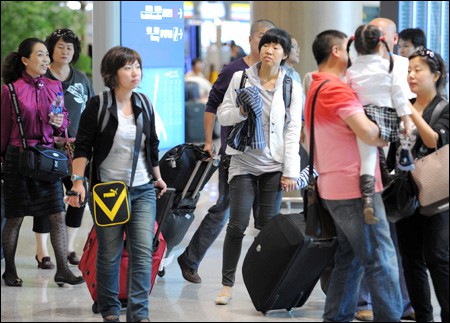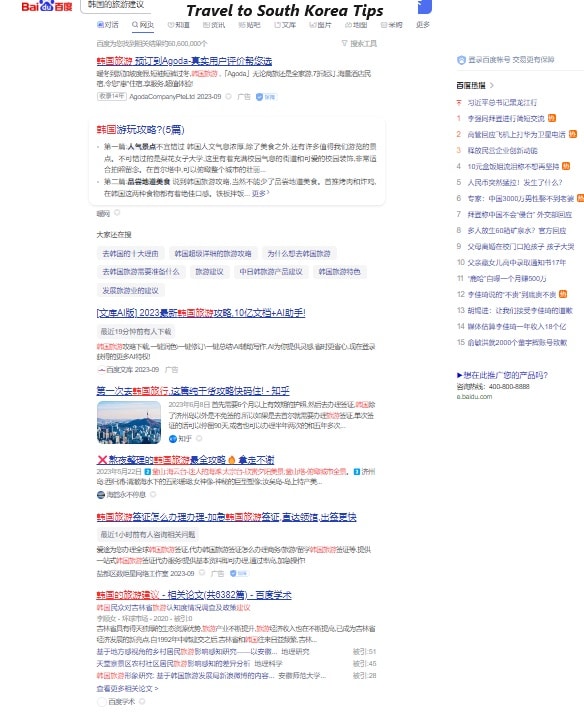The future Boom of Chinese Tourists to South Korea
Tourism Synergies Between South Korea and China
- Visa Waiver Initiative: South Korea is strategically waiving visa processing fees for Chinese visitors till December, capitalizing on China’s recent upliftment of a six-year group tour ban to South Korea.
- Aviation Uplift: Enhanced air connectivity is on the horizon with an increase in flight frequencies, set to boost bilateral tourism.
- Economic Boost Through Tourism: By exempting the visa fee, valued at approximately $13.60, South Korea aims to stimulate its economy by tapping into the lucrative Chinese tourist market.
- Streamlining Tourist Arrivals: Seoul has facilitated easier access for tourists from 22 nations by exempting the Korean Electronic Travel Authorization (K-ETA) requirement for short-term business and leisure visits.
- Cultural Exchanges and Global Events: Collaboration between Beijing and Seoul is being fortified with platforms like group tours and the upcoming Asian Games in Hangzhou – a strategic move to boost bilateral ties and tourism.
- Historical Hurdles: The 2017 group tour ban from China was a direct response to South Korea’s decision to incorporate the U.S. Terminal High Altitude Area Defense system (THAAD). Overcoming such historical impediments is crucial for mutual tourism growth.
- Economic Incentives: South Korea is enhancing its shopping incentives by offering tax-free shopping and increased VAT refunds for Chinese tourists – a strategic effort to attract higher tourist spending.
- Bilateral Trade Dynamics: While China remains South Korea’s paramount trade partner, it’s essential to recognize the fluctuating dynamics due to geopolitical factors. Current sentiments indicate a more favorable South Korean outlook towards the U.S. and Japan over China. source
- Diplomatic Engagements: High-level dialogues are being prioritized by both nations. South Korea’s Foreign Minister, Park Jin, and his Chinese counterpart, Wang Yi, have emphasized on boosting high-level communications, further stabilizing the investment environment.
- Navigating Global Relations: Recent trilateral engagements, such as the Camp David summit, have emphasized regional collaboration. Chinesetouristagency advice for both nations is clear: bilateral relations should remain unswayed by external factors.

Chinesetourisagency overview
South Korea’s strategic tourism initiatives targeting the Chinese market could be a game-changer. The blend of visa facilitations, cultural exchanges, economic incentives, and high-level diplomatic engagements is designed to usher in a new era of bilateral tourism and economic prosperity.
trategic Recommendations: Korea’s Tourism Market Capitalizing on Chinese Tourists
1. Digital Payment Infrastructure
- Case Study: France’s Adoption of Chinese Digital Payments
- In 2018, France adopted WeChat Pay, a significant step to attract the 938 million monthly users from China.
- Beyond large retailers, smaller establishments in France also integrated WeChat’s QR code system.
- For South Korea, this presents an opportunity. A Korean case in point: Some major malls in Seoul began accepting WeChat Pay, reporting a surge in sales directly attributable to Chinese tourists.

2. Visibility in Chinese Social Media
- Leveraging Platforms: Brands aiming for visibility in China should consider platforms like Weibo (China’s Facebook) and WeChat. Both platforms allow for widespread outreach and Popularity
- Engage Chinese KOLs:
- Case Study: Chinese Travel Influencer Leila
- Leila commands an audience of 4.5 million on Weibo. Engaging with such influencers could be a game-changer for Korean tourism brands.
- Collaborations with KOLs, however, necessitate vetting, as the authenticity of their following is vital. Engaging a professional agency to mitigate potential scams is advised. So many KOLs dream to travel to South Korea anyway
- Case Study: Chinese Travel Influencer Leila
3. WeChat as a Strategic Tool

- Beyond being a payment tool, WeChat serves as a comprehensive platform for services and brand engagement.
- Case Study: Brands’ Engagement on WeChat in China
- Numerous brands utilize Official WeChat accounts to engage with the 900 million monthly active users.
- For Korea, tapping into WeChat not only for payment but also for promotions, news, and engagement could be transformative. As an instance, a prominent Korean skincare brand successfully leveraged WeChat to disseminate product information and special promotions to its Chinese audience.
4. Optimization for Chinese Search Engines

- Why It’s Vital: When Chinese tourists research travel destinations or brands, they often use platforms like Baidu so.com or Sogou. Ensuring brand visibility on these platforms is paramount.
- Strategic Actions:
- Create a Chinese-translated version of websites to show inclusivity towards Chinese tourists.
- List businesses on popular Chinese travel forums, wiki sites, and niche blogs.
- Korean Case Study: A famous cultural village in Korea saw a spike in Chinese tourists after it optimized its online presence for Chinese search engines, illustrating the importance of such digital strategies.

Top reading
Chinesetouristagency Summary:
To bolster the inflow of Chinese tourists to South Korea, strategic integration of Chinese digital payment systems, active engagement on key Chinese social media platforms, collaborations with genuine Chinese influencers, and optimization for Chinese search engines is crucial. By looking at successful implementations in other markets and within Korea itself, the tourism sector can craft a strategic roadmap to attract this lucrative market segment.






